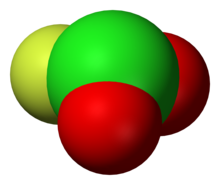Chloryl fluoride

| |
| Names | |
|---|---|
| Other names
chlorine dioxide fluoride
| |
| Identifiers | |
3D model (
JSmol ) |
|
| ChemSpider | |
PubChem CID
|
|
CompTox Dashboard (EPA)
|
|
| |
| |
| Properties | |
| ClFO2 | |
| Molar mass | 86.45 g·mol−1 |
| Density | 3.534 g/L |
| Melting point | −115 °C |
| Boiling point | −6 °C |
| Related compounds | |
Related compounds
|
Chloryl trifluoride
|
Except where otherwise noted, data are given for materials in their standard state (at 25 °C [77 °F], 100 kPa).
| |
Chloryl fluoride is the
.Preparation
ClO2F was first reported by Schmitz and Schumacher in 1942, who prepared it by the fluorination of ClO2.[2] The compound is more conveniently prepared by reaction of sodium chlorate and chlorine trifluoride[3] and purified by vacuum fractionation, i.e. selectively condensing this species separately from other products. This species is a gas boiling at −6 °C:
- 6 NaClO3 + 4 ClF3 → 6 ClO2F + 2 Cl2 + 3 O2 + 6 NaF
Structure
In contrast to
VSEPR. The differing structures reflects the greater tendency of chlorine to exist in positive oxidation states with oxygen and fluorine ligands. The related Cl-O-F compound perchloryl fluoride
, ClO3F, is tetrahedral.
The related bromine compound bromyl fluoride (BrO2F) adopts the same structure as ClO2F, whereas iodyl fluoride (IO2F) forms a polymeric substance under standard conditions.[4]
References
- ISBN 0-471-83441-6
- ISSN 0863-1786.
- OCLC 48056955.
- ISBN 9783110126419. Retrieved 2015-02-20.
